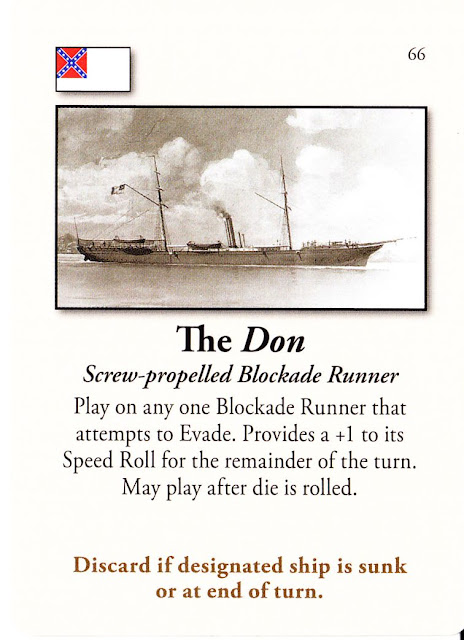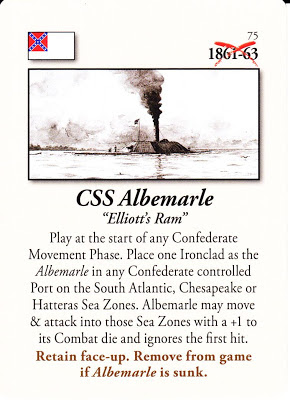Rebel Raiders Replay (Turn 9 –December 1863) Part 2: The Night They Drove Ole Dixie Down
Designer Mark
McLaughlin as CSA; Naval Historian Brandon Musler as USA
When we last left
off, the North had driven Southeast from Nashville, taking first Chattanooga, then Kennesaw Mountain, placing the Union adjacent to the beating heart of the Confederacy - Atlanta. Brandon had also swept the seas of ALL Blockade Runners - catching all 8 during the Rebel turn. Mark has built a few more, and has put in play the mighty Raider ALABAMA! (whose picture appears on the cover of Rebel Raiders on the High Seas). Now, the Union strikes...Brandon is confident that...
This will be THE Night
They Drove Ole Dixie DOWN!
Atlanta, the biggest naval battle of the game so far…and off a
Raider-hunting we go!
Half-singing the title and key line from Joan Baez’s classic
folk tune as noted above, Brandon gleefully
pulls off many of the Screw Sloops from the outer ring of the blockade to go
hunting Raiders – and puts no fewer than FOUR off Spain,
where Alabama will begin her
maiden voyage.
The South now has Five Raiders, including Alabama, and while Brandon fails to
find any of the four at sea, each is now covered by at least one Screw Sloop
and most also have a Screw Sloop in one or more sea zones around them – this
makes raiding much more chancy of a profession….as every time a Raider moves
into or raids, it triggers a speed roll by any Screw Sloops present.
Forts Jackson and St.
Philip
Despite sending so many big warships out into the Atlantic,
Brandon still has enough in the
Gulf that he can muster SIX to attack Forts Jackson and St. Philip. The South plays Mosquito Fleet (Card 81) and
doubles the size of the Rebel flotilla there (to TWO gunboats), and with the Battery
makes a desperate and heroic – if sadly, doomed – stand. The Gunboats are sunk, the Battery
is destroyed, but they take down two Union Screw Sloops with them.
Atlanta and Memphis
The blue-water Navy actions done with, Brandon
turns the Army on to Atlanta. The South rolls a modified 8 on the dice (a
“6” plus three ones – and triples add 2 to the high die total). The Union Tactics play also yields an 8 – and
Brandon decides NOT to risk a
re-roll with Grant (as it would be both pointless and would only give the South
victory points from the difference in dice). Since the Confederacy wins ties, the first Union assault on Atlanta is repulsed!
Mark is visibly relieved, and picks up the dice assuming Brandon
will come at Atlanta again with
another assault – but he doesn’t!
Switching focus, he has Thatcher gather up SIX Ironclads and sends them
into Memphis!
The Biggest Naval Battle of the Game - Memphis!
Six Union Ironclads oppose three Rebel Ironclads with a
Gunboat and three Batteries. Brandon
admits this is a “battle of attrition,” and pins his hopes on Yankee Guns (Card 3) and its re-rolls for one round of naval combat as selected by the Union to clear the way, if not for an Assault, then
for a second wave of ships to come down the river.
Mark has several options here.
-(1) Hide the Fleet
behind the Batteries.
If he does this, the Rebel warships will not fire but
neither will they be fired upon. The
North can NOT make an assault along the River if ANY Rebel ships are
present. This would bring about a nearly
even fight (six Ironclads, with one die each, vs. three Batteries, with two
dice each, both sides needing “6s” on dice to hit), although with Yankee Guns
the North would get one re-roll per ship ..giving it effectively twice as many
shots.
While the Batteries might lose they would weaken the Union
fleet, which would still have to take on the Rebel Navy if an Assault is to be
carried through on the city.
-(2) Hide the Batteries behind the Fleet.
If he does this, the three Rebel Ironclads and single
gunboat are surely facing doom, being outgunned in dice by three to one (six
Ironclads, one die each per ship, one die each per re-roll) but it could knock
one or two Yankee ships out, and leave the Yankee ironclads to face the
Batteries without their re-rolls (each ship can only use ONE
re-roll per battle with Yankee Guns).
Unfortunately, should the Rebel ships go down, the North can
still launch its Assault – although Brandon
would surely go in for at least one or two rounds to try to take out the
Batteries and thus improve his odds of hitting the city.
-(3) All on the Line.
This third option puts every Rebel piece into the line. It maximizes Rebel firepower and gives the
Yankees more targets than they can hit, although as they can still pick and
choose. It gives the North the option
to go all in for batteries or put everything against ships. This is Mark’s choice.
The Big Battle Commences:
man-o-war a man-o-war
Brandon decides
to go man-o-war a man-o-war (and Battery). He puts one Ironclad against each Battery
and Ironclad.
In Round One, with Six initial dice and five re-rolls, Brandon
manages to sink only 1 Rebel Ironclad.
The South, with Ten dice (two per each of the three Batteries, one per
each of the four ships), returns the favor and sinks 1 Union Ironclad.
Round Two sees the Union miss
entirely, and lose an Ironclad.
Brandon retreats
his four remaining Ironclads…thus ending this, his second Assault of the
turn. He still has two more Assault
cannon, however, and this time he comes in by land.
With three Batteries still intact, that is three dice to add
to the normal two for Confederate defenders.
The Union has only three dice (it is still
1863)….the result is a tie; the Union is repulsed.
“Live by the dice,
die by the dice” murmurs Brandon, who spends his builds to replace the two
Ironclads and one of the Sloops he lost, and to buy a third Assault for next
turn.
To be Continued….
























.jpg)














